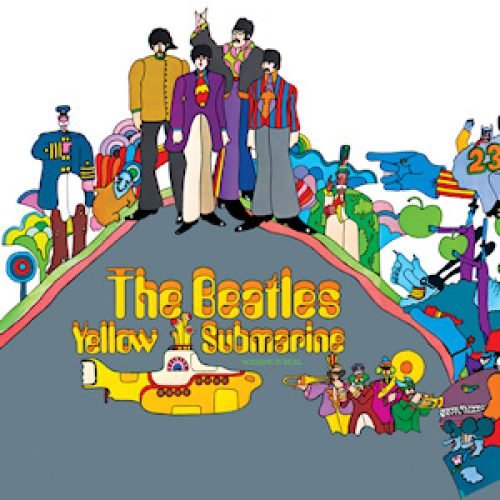In the vast and transformative discography of The Beatles, “Yellow Submarine” emerges not just as an album but as a vivid tableau of artistic exploration, at once a reflection of its era and a pioneering gesture toward the future of music and animation. Released in 1969, amidst a tumultuous period marked by global unrest and cultural shifts, this album and its accompanying animated film offered a much-needed respite through its embrace of whimsy, vibrant storytelling, and a call for peace that transcended linguistic and cultural barriers.
“Yellow Submarine” stands out as an anomaly within The Beatles‘ body of work. While their previous albums, such as “Sgt. Pepper’s Lonely Hearts Club Band” and “The White Album,” showcased their evolving musicianship, experimentation with different genres, and increasingly sophisticated lyrical themes, “Yellow Submarine” took a divergent path. It delved into the realm of psychedelic rock and art, engaging with a younger audience and providing an audiovisual experience that was pioneering for its time. This was a venture into a more fantastical, narrative-driven project, which allowed the band to expand their artistic expression beyond traditional music-making.
Artistic Intentions
The artistic intentions behind “Yellow Submarine” were multifaceted. At its core, the album served to soundtrack the animated film of the same name, a project that was as much a visual experiment as it was a musical one. The Beatles aimed to create a work that was accessible and enjoyable for children and adults alike, embedding messages of love, unity, and peace in a period rife with conflict. Through songs like “All You Need Is Love” and the titular “Yellow Submarine,” they crafted anthems that resonated widely, promoting optimism and camaraderie in the face of adversity. Furthermore, the use of groundbreaking animation techniques and vibrant, surreal imagery in the film mirrored the album’s departure from conventional aesthetics, aligning with the psychedelic and experimental movements of the late 1960s.
I love cartoons, I love the Disney stuff. So, you know, the first thing when we heard people were going to do a cartoon I just thought yeah this could be greatest Disney cartoon ever. I mean with our music, but they were going to go more pepper direction. So we said, well why don’t you just take a lot of songs we’ve got already?
Paul McCartney on Yellow Submarine
The Beatles, through interviews and album notes, have expressed their desire to explore new artistic terrain with “Yellow Submarine.” They saw the project as an opportunity to push the boundaries of their musical and visual artistry, engaging with themes of peace, love, and collective happiness in innovative ways. It was a bold step into a new artistic direction, one that would influence not only the music industry but also the fields of animation and film for decades to come.
Sonic Exploration

The sonic landscape of “Yellow Submarine” is as expansive and colorful as the animated world it conjures, marked by a production quality that blends clarity with whimsy, and arrangements that weave a tapestry of sound as imaginative as the visuals it accompanies. Produced in an era when stereo sound was becoming more sophisticated and the capabilities of studio production were rapidly expanding, the album leverages these technological advances to serve its fantastical themes and vibrant mood.
Production Quality
The production on “Yellow Submarine” is notably crisp and clear, especially considering the technological limitations of the time. George Martin, often referred to as the “Fifth Beatle” for his extensive contribution to the band’s sound, helmed the album’s production. His expert craftsmanship is evident in the album’s ability to maintain auditory clarity while navigating a plethora of sound effects, orchestral arrangements, and genre explorations. This clarity does not come at the expense of warmth; the album’s production retains a rich, enveloping quality that draws listeners into its narrative world. The decision to prioritize a clean production style amplifies the album’s themes of joy, adventure, and camaraderie, allowing each musical element to shine through and contribute to the story being told.
Musical Arrangements
“Yellow Submarine” is a showcase of innovative musical arrangements, with The Beatles and George Martin experimenting with orchestral elements, sound effects, and a diverse array of instruments. From the playful call-and-response in “All Together Now” to the lush, immersive soundscape of “Sea of Time,” the arrangements push the boundaries of conventional pop and rock music. The titular track, “Yellow Submarine,” features sound effects that evoke the feeling of being underwater, including bubbly echoes and maritime bells, which complement the singalong style vocals and simple, catchy melody.
Genre Elements
The Beatles were never ones to confine themselves to a single genre, and “Yellow Submarine” continues this tradition of genre-blending with gusto. The album touches upon psychedelic rock, pop, classical, and folk music, weaving these styles together to create a soundscape as varied and dynamic as the underwater world it depicts. Psychedelic elements are especially prominent, aligning with the album’s visual and thematic emphasis on fantasy and imagination. Songs like “Only a Northern Song” and “It’s All Too Much” revel in psychedelic rock’s characteristic use of unconventional scales, feedback, and studio effects, creating an immersive auditory experience that mirrors the album’s exploration of otherworldly landscapes.
Lyrical Analysis

In the vibrant mosaic that is “Yellow Submarine,” The Beatles craft a lyrical landscape that dives into themes of peace, unity, and the boundless realms of the imagination. Situated within this colorful album, the lyrics serve as a beacon of optimism and camaraderie, guiding listeners through an underwater world that mirrors the tumult and hope of the human condition.
Themes and Messages
At the heart of “Yellow Submarine” are the universal themes of adventure and companionship. The title track, “Yellow Submarine,” encapsulates this spirit with its whimsical depiction of life aboard the eponymous vessel, symbolizing a communal journey through life’s ups and downs. The song becomes an anthem of togetherness, inviting everyone to join in the singalong, reinforcing the idea that joy is best shared.
“Yellow Submarine” as an album is unique in that it is partially comprised of George Martin’s orchestral compositions for the film, which instrumental tracks like “Pepperland” and “Sea of Time” contributing to the thematic richness without lyrics. These pieces evoke a sense of wonder and exploration that complements the album’s vocal tracks.
The lyrics of “All Together Now” further emphasize inclusivity and simplicity, with its catchy, repetitive chorus inviting listeners of all ages to join in the fun. This song, with its straightforward appeal, promotes a message of unity and collective joy, making it accessible and resonant with a wide audience.
Lyrical Depth
While much of “Yellow Submarine” is characterized by its direct and engaging lyrics, songs like “Nowhere Man” (although not originally part of the “Yellow Submarine” soundtrack, but fitting within its themes) suggest a deeper introspection beneath the album’s playful surface. However, focusing strictly on the tracks within “Yellow Submarine,” the balance between straightforward singalong songs and instrumental compositions offers a unique kind of lyrical depth through its absence. The instrumental tracks, while not lyrical in the traditional sense, communicate emotion and narrative through music alone, showcasing the band’s and Martin’s ability to convey complex themes without words.
Emotional Impact
The emotional impact of “Yellow Submarine” is largely one of joy, nostalgia, and communal spirit. Even in its more reflective moments, the album maintains a sense of hope and positivity. “All You Need Is Love,” featured in the reprise, encapsulates this sentiment, serving as a timeless reminder of love’s enduring power. The album, through its mix of lively singalongs and imaginative soundscapes, invites listeners to find solace and joy in togetherness, offering a refuge from the outside world.
Cohesion and Flow

In assessing the cohesion and flow of The Beatles’ “Yellow Submarine,” it’s crucial to understand the album’s unique structure and purpose. Unlike traditional albums, “Yellow Submarine” functions as both a soundtrack and a thematic exploration, bridging the auditory and visual components of its companion animated film. This dual purpose presents unique challenges and opportunities in achieving a seamless progression of tracks and maintaining thematic consistency.
Track Progression
The album is distinguished by its division into two distinct halves: the first side features Beatles songs including the title track “Yellow Submarine,” and “All You Need Is Love,” among others, while the second side comprises George Martin’s orchestral compositions for the film’s score. This structure inherently influences the flow, creating a division between the more conventional songs of Side A and the instrumental, cinematic pieces of Side B.
Despite this division, the transition between the two halves is surprisingly smooth, attributed to the overarching theme of a whimsical, underwater adventure that unifies the album. The early tracks set the stage with their lively and engaging songs, inviting listeners into the fantastical world of “Yellow Submarine.” As the album progresses into Martin’s orchestral pieces, the listener is already primed for a journey into the unknown, allowing the instrumental tracks to further elaborate on the narrative and emotional themes introduced in the first half.
Thematic Consistency
Thematic consistency is one of the album’s strengths, with the concept of a magical, musical odyssey underpinning both the Beatles’ songs and Martin’s compositions. The themes of adventure, unity, and peace are woven throughout the album, not just lyrically but also through the musical motifs and styles that recur in both halves. The use of whimsical sound effects and melodic lines in songs like “Yellow Submarine” finds an echo in the playful and imaginative arrangements of Martin’s orchestral pieces.
However, the transition from pop songs to orchestral compositions might seem jarring to some listeners, especially those expecting a more traditional Beatles album. Yet, for those immersed in the album’s narrative context — the soundtrack to an animated fantasy — the shift underscores the film’s transition from the familiar world to the fantastical realms of Pepperland, enhancing the thematic journey rather than detracting from it.
Standout Tracks and Moments
“Yellow Submarine” is an album replete with innovation, artistic exploration, and moments of profound emotional resonance. Within its diverse soundscape, certain tracks and moments stand out, not only for their musicality but for their contribution to the album’s overarching narrative and thematic richness.
Key Tracks
“Yellow Submarine”: The eponymous track is undoubtedly one of the album’s most iconic songs. Its singalong chorus, imaginative lyrics, and vivid sound effects create an immersive listening experience that transports audiences into the Beatles’ whimsical underwater world. Its simplicity in melody contrasts with the complexity of its production, making it a standout piece for its ability to appeal to both children and adults alike, embodying the album’s themes of unity and adventure.
“All You Need Is Love”: Featured towards the album’s end, this track stands out for its message of universal love and peace. With its memorable chorus and incorporation of the French national anthem, it serves as a powerful anthem for the late 1960s peace movement. The song’s optimistic message, combined with its innovative mixing and layering of sounds, showcases The Beatles’ ability to create music that resonates on a global scale.
Memorable Moments
The Laugh in “Yellow Submarine”: Amidst the sound effects and vocal lines in “Yellow Submarine,” a distinctive laugh cuts through, adding a layer of joy and spontaneity to the track. This moment encapsulates the spirit of the album — playful, communal, and slightly irreverent, inviting listeners to join in the fun.
The Orchestral Crescendo in “Pepperland”: George Martin’s “Pepperland,” which opens Side B of the album, features a moment where the orchestral arrangement builds to a stirring crescendo. This not only showcases Martin’s compositional genius but also effectively transitions the listener from the Beatles’ pop-oriented first half into the more expansive, cinematic second half. It serves as a bridge between two musical worlds, highlighting the album’s ambitious scope.
The Transition into “Sea of Time”: In “Sea of Time,” there’s a moment where the music shifts, incorporating Indian instruments and rhythms that evoke a sense of timeless adventure and exploration. This moment is particularly memorable for its ability to transport the listener, showcasing The Beatles’ and Martin’s willingness to experiment with diverse musical styles and cultural influences, further enriching the album’s narrative depth.
These tracks and moments are emblematic of “Yellow Submarine”‘s enduring appeal. They highlight The Beatles’ and George Martin’s innovative spirit, blending familiar pop elements with experimental sounds and themes to create an album that is both a product of its time and timeless in its artistic ambition. “Yellow Submarine” remains a testament to the power of music to enchant, to convey profound messages, and to bring people together in shared experience and imagination.
Artistic Contribution and Innovation

“Yellow Submarine” occupies a unique place in The Beatles’ discography, the broader landscape of rock and pop music, and the music industry as a whole. It stands as a testament to the band’s relentless pursuit of artistic experimentation and their ability to transcend the boundaries of genre, medium, and message. This album, while deeply rooted in the psychedelic era of the late 1960s, managed to carve its own niche, pushing the envelope in terms of production, thematic exploration, and the integration of music with visual storytelling.
Place in Genre/Industry
In the context of its genre, “Yellow Submarine” diverges significantly from the rock and pop norms of its time. It’s an amalgamation of psychedelic rock, pop, classical orchestration, and film soundtrack, creating a multimedia experience rather than just an auditory one. This blend of music with animation was pioneering, setting a precedent for future multimedia projects and concept albums in the industry. The Beatles were at the forefront of this innovation, using “Yellow Submarine” to explore the potential of music as part of a larger narrative and visual experience, thereby expanding the scope of what an album could represent within the music industry.
Innovation
Multimedia Integration
The album’s close ties with the animated film of the same name was groundbreaking. This integration of music with visual art not only enhanced the storytelling aspect of the album but also influenced the way music could be consumed, appreciated, and understood in a broader cultural and artistic context.
Production Techniques
The production on “Yellow Submarine,” overseen by George Martin, incorporated advanced studio techniques of the time, including innovative use of sound effects, tape loops, and stereo mixing. These elements added depth and dimension to the album, pushing the boundaries of what could be achieved in the recording studio.
Thematic Exploration and Narrative Structure
The album’s exploration of themes such as peace, love, and the power of imagination, coupled with its narrative structure tied to the film, showcased The Beatles’ willingness to delve into more conceptual and thematic projects. This approach to album-making as a cohesive work with a storyline or underlying theme was relatively novel and contributed significantly to the evolution of the concept album in rock music.
Genre Blending
“Yellow Submarine” stands out for its seamless blending of genres, from rock and pop to classical and avant-garde. This not only showcased The Beatles’ and Martin’s versatility as musicians and composers but also challenged the industry’s genre conventions, encouraging a more fluid and inclusive understanding of musical categorization.
In summary, “Yellow Submarine” is a hallmark of The Beatles’ legacy, reflecting their status as pioneers in the music industry. Its artistic contribution lies not just in its innovative production and genre-defying music but also in its bold thematic vision and integration with film. The album pushed the boundaries of what music could convey, expanding the possibilities for storytelling, emotional expression, and cross-medium collaboration in the industry. Through “Yellow Submarine,” The Beatles affirmed their role as cultural icons capable of reshaping the artistic landscape of their time.
Closing Thoughts

“Yellow Submarine” stands as a unique and colorful chapter in The Beatles’ illustrious career, a project that diverged significantly from their more conventional albums to explore new artistic territories. Its strengths are manifold, showcasing the band’s and George Martin’s innovative spirit in blending diverse musical genres, integrating music with visual art, and experimenting with studio production techniques. The album’s narrative cohesion, thematic exploration of peace, love, and imagination, and its pioneering role in the multimedia experience mark significant achievements in The Beatles’ discography and the broader music industry.
However, “Yellow Submarine” is not without its weaknesses. The division between the Beatles’ songs and Martin’s orchestral compositions, while innovative, may disrupt the listening experience for those seeking a more traditional album structure. Additionally, the album’s focus on serving as a soundtrack to an animated film may dilute its musical impact compared to other Beatles albums that are more focused on exploring complex themes or pushing the boundaries of pop and rock music. These factors, coupled with the varied reception of its more whimsical and child-oriented content, contribute to its perception as a lesser work within The Beatles’ oeuvre for some critics and fans.
Official Rating
Given these considerations, a rating of 6 out of 10 reflects the album’s place as a noteworthy yet niche entry in The Beatles’ catalog. It’s a score that acknowledges the album’s artistic ambitions and contributions to multimedia storytelling, while also recognizing its limitations in offering a cohesive musical experience comparable to the band’s more acclaimed works.
